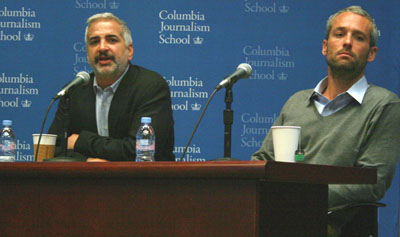On March 15, four New York Times journalists were detained in Libya while crossing a checkpoint after they entered the country without visas. They were released six days later. The four–photojournalists Lynsey Addario and Tyler Hicks, and reporters Anthony Shadid and Stephen Farrell–came to Columbia University’s Graduate School of Journalism on Thursday for what will be their only public event. The panel was moderated by Columbia Professor Ann Cooper, who was formerly CPJ’s executive director.
Hicks evenly told a packed audience that the four of them were blindfolded and shoved into a pick-up truck for a six-hour drive to Tripoli. Every time the soldiers passed a checkpoint, the journalists were hit and shouted at, he said. “These people are real thugs,” Hicks said of his captors. “They are people who shoot first and ask questions later. We were clinging onto the idea that we would meet someone who could say, ‘Look, they are journalists.’ But that never happened. Every single person we were passed to was worse than the previous one.”
“It was very clear that they didn’t care that we were journalists,” Addario said, adding that she was frequently touched by her captors. “The risks are different for a woman,” she said, although she did make it clear that she felt she had suffered no more than her fellow captives. “Yes, it was traumatic being groped and blindfolded, but the others were being punched in the face.” Addario too was punched in the face.
Anthony Shadid, the Times‘ Beirut bureau chief, played down that he could speak Arabic, he said, realizing that he would likely be at greater risk if he were seen to be local in some way. CPJ’s statistics show that of all the journalists killed around the world, 87 percent are locals. “It’s amazing to me how much more dangerous it is for Arab journalists working out there,” Shadid said.
CPJ has counted 300 attacks on journalists in the Middle East since unrest began in February, including six deaths. In Libya alone, there have been more than 60 attacks on the press so far. Four journalists from Al-Jazeera and six local journalists are still missing.
“The situation is still evolving,” said Addario. “It’s a very specific story because all the cities fall back and forth between the hands of the rebels and the government.” She added that the terrain is mostly flat, which means there are no places to hide. “You have to do your homework every moment of every day,” she said. “There are places you can go and places you can’t.”
Shadid told the crowd that many locals had offered to be their drivers or their translators for free, because they wanted the story of their country’s collapse told. But everyone knew it was dangerous, said Addario. “You can’t force someone to work with you, but you can push them too far,” she said in an emotional moment.
The four journalists said they lost sight of their driver, Mohamed Shaglouf, when they were captured. He is still missing to this day.
“We’re taking these risks because the story wouldn’t be told otherwise,” said Shadid. “That’s what I tell myself. We do have to live with the burden that the choices we made may have gotten someone killed.”
